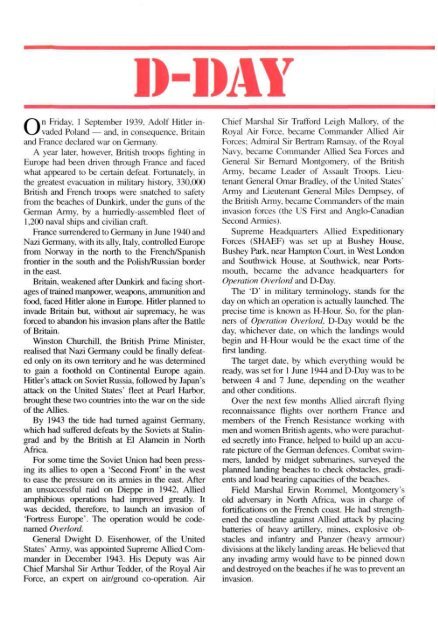ISSUE 107 : Jul/Aug - 1994 - Australian Defence Force Journal
ISSUE 107 : Jul/Aug - 1994 - Australian Defence Force Journal
ISSUE 107 : Jul/Aug - 1994 - Australian Defence Force Journal
Create successful ePaper yourself
Turn your PDF publications into a flip-book with our unique Google optimized e-Paper software.
D-DAYOn Friday. 1 September 1939. Adolf Hitler invadedPoland — and, in consequence. Britainand France declared war on Germany.A year later, however. British tnxips fighting inEurope had been driven through France and facedwhat appeared to be certain defeat. Fortunately, inthe greatest evacuation in military history. 330,000British and French troops were snatched to safetyfrom the beaches of Dunkirk, under the guns of theGerman Army, by a hurriedly-assembled fleet of1,200 naval ships and civilian craft.France surrendered to Germany in June 1940 andNazi Germany, with its ally, Italy, controlled Europefrom Norway in the north to the French/Spanishfrontier in the south and the Polish/Russian borderin the east.Britain, weakened after Dunkirk and facing shortagesof trained manpower, weapons, ammunition andfood, faced Hitler alone in Europe. Hitler planned toinvade Britain but, without air supremacy, he wasforced to abandon his invasion plans after the Battleof Britain.Winston Churchill, the British Prime Minister,realised that Nazi Germany could be finally defeatedonly on its own territory and he was determinedto gain a foothold on Continental Europe again.Hitler's attack on Soviet Russia, followed by Japan'sattack on the United States' fleet at Pearl Harbor,brought these two countries into the war on the sideof the Allies.By 1943 the tide had turned against Germany,which had suffered defeats by the Soviets at Stalingradand by the British at El Alamein in NorthAfrica.For some time the Soviet Union had been pressingits allies to open a 'Second Front' in the westto ease the pressure on its armies in the east. Afteran unsuccessful raid on Dieppe in 1942, Alliedamphibious operations had improved greatly. Itwas decided, therefore, to launch an invasion of'Fortress Europe'. The operation would be codenamedOverlord.General Dwight D. Eisenhower, of the UnitedStates' Army, was appointed Supreme Allied Commanderin December 1943. His Deputy was AirChief Marshal Sir Arthur Tedder, of the Royal Air<strong>Force</strong>, an expert on air/ground co-operation. AirChief Marsha] Sir Trafford Leigh Mallory. of theRoyal Air <strong>Force</strong>, became Commander Allied Air<strong>Force</strong>s: Admiral Sir Bertram Ramsay, of the RoyalNavy, became Commander Allied Sea <strong>Force</strong>s andGeneral Sir Bernard Montgomery, of the BritishArmy, became Leader of Assault Troops. LieutenantGeneral Omar Bradley, of the United States'Army and Lieutenant General Miles Dempsey, ofthe British Army, became Commanders of the maininvasion forces (the US First and Anglo-CanadianSecond Armies).Supreme Headquarters Allied Expeditionary<strong>Force</strong>s (SHAEF) was set up at Bushey House,Bushey Park, near Hampton Court, in West Londonand Southwick House, at Southwick, near Portsmouth,became the advance headquarters forOperation Overlord and D-Day.The 'D' in military terminology, stands for theday on which an operation is actually launched. Theprecise time is known as H-Hour. So, for the plannersof Operation Overlord. D-Day would be theday, whichever date, on which the landings wouldbegin and H-Hour would be the exact time of thefirst landing.The target date, by which everything would beready, was set for 1 June 1944 and D-Day was to bebetween 4 and 7 June, depending on the weatherand other conditions.Over the next few months Allied aircraft flyingreconnaissance flights over northern France andmembers of the French Resistance working withmen and women British agents, who were parachutedsecretly into France, helped to build up an accuratepicture of the German defences. Combat swimmers,landed by midget submarines, surveyed theplanned landing beaches to check obstacles, gradientsand load bearing capacities of the beaches.Field Marshal Erwin Rommel. Montgomery'sold adversary in North Africa, was in charge offortifications on the French coast. He had strengthenedthe coastline against Allied attack by placingbatteries of heavy artillery, mines, explosive obstaclesand infantry and Panzer (heavy amour)divisions at the likely landing areas. He believed thatany invading army would have to be pinned downand destroyed on the beaches if he was to prevent aninvasion.
















